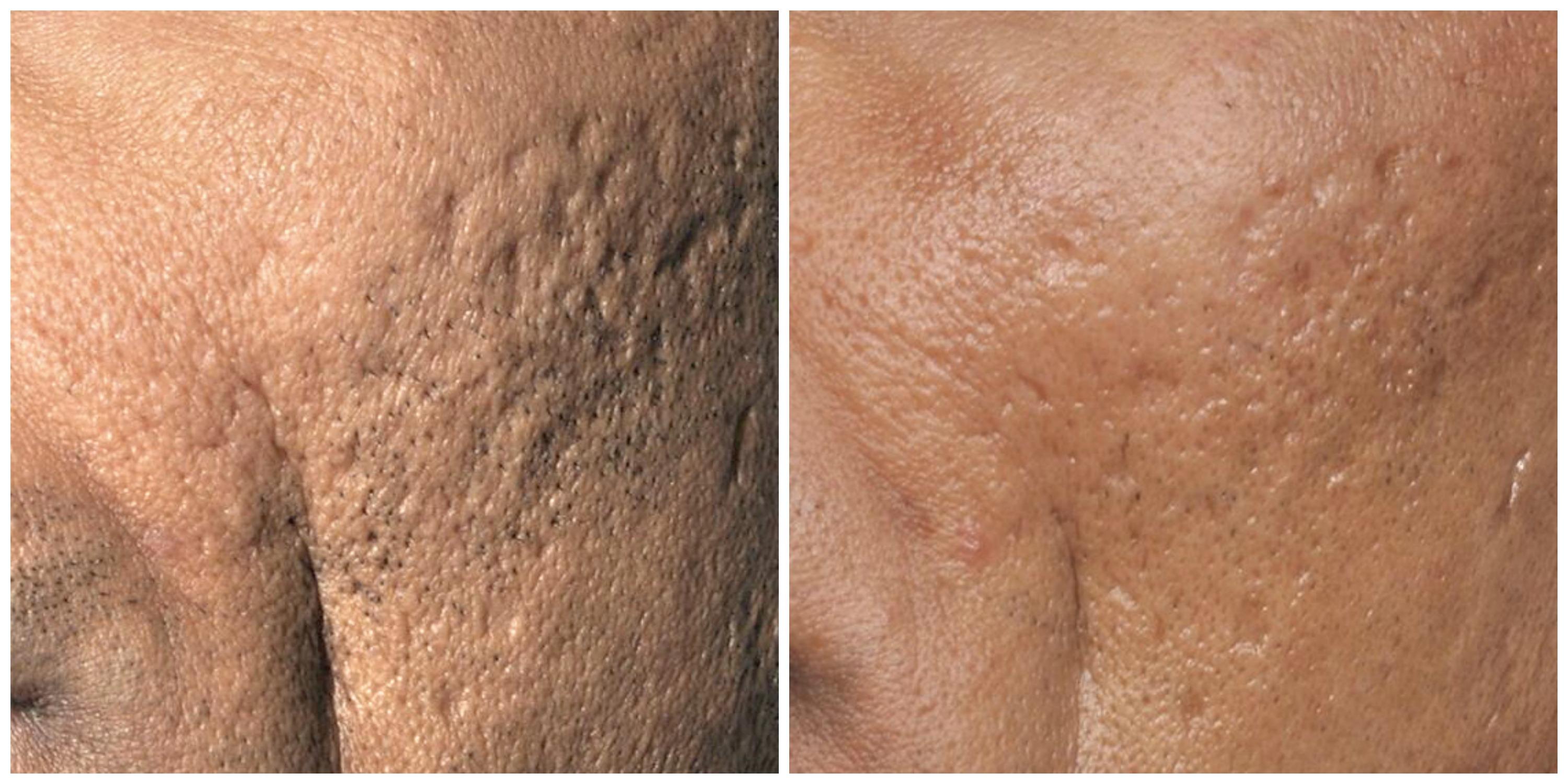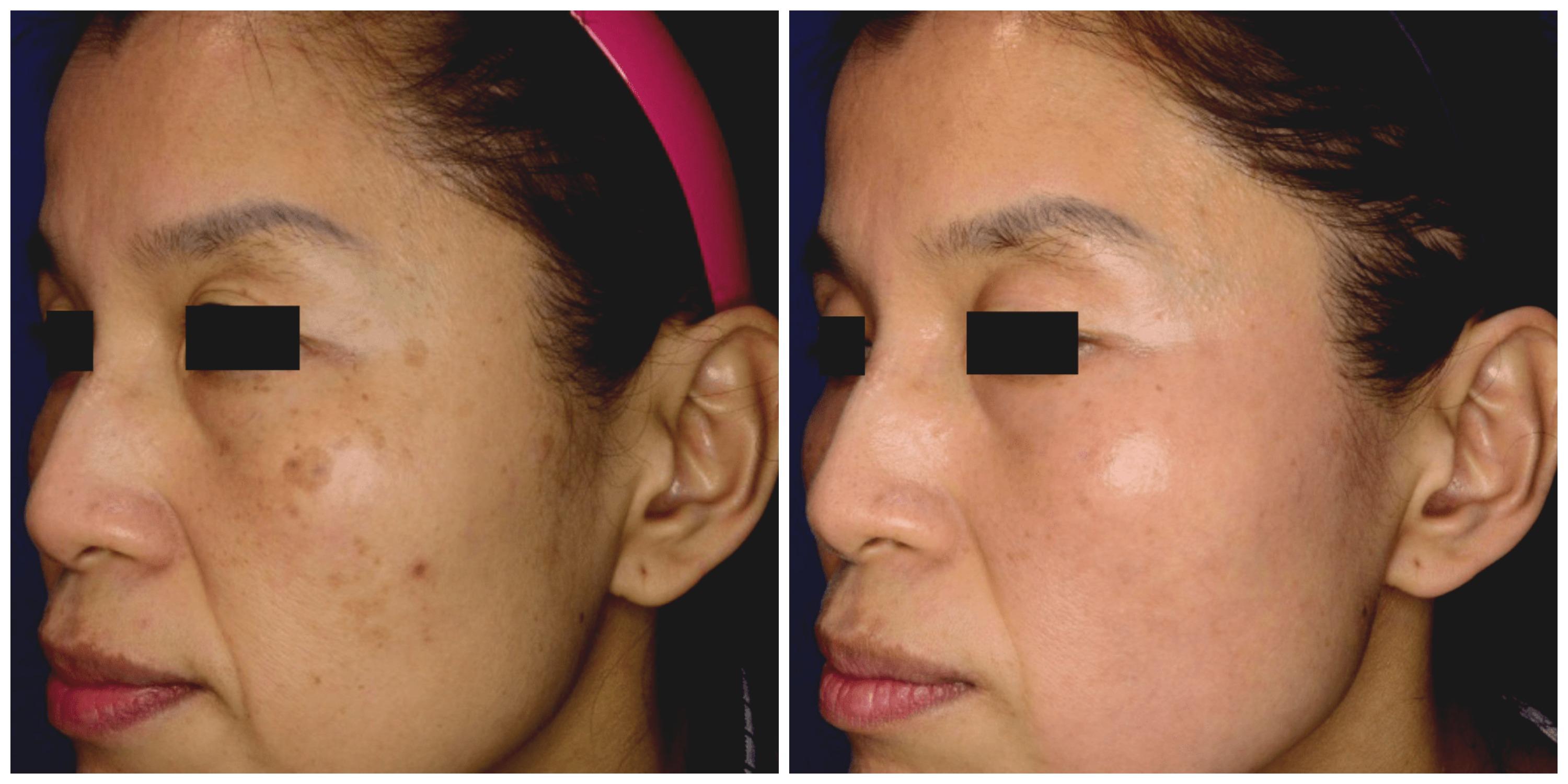After PicoSure Focus, follow post-treatment care instructions, including avoiding sun exposure, using sunscreen, and keeping the treated area clean and moisturized for optimal results.
The effects of Pico laser, such as skin improvement and reduction of pigmentation, are often visible within a few days to a few weeks after treatment, with optimal results appearing over several sessions.
Before PicoSure laser, avoid sun exposure and tanning, discontinue use of certain medications that increase photosensitivity, and inform your provider about any recent skin treatments or use of topical products containing retinoids to minimize potential side effects.
PicoSure Focus works by delivering ultra-short pulses of laser energy to break down pigmentation and stimulate collagen production, promoting skin rejuvenation and improvement in texture, tone, and pigmentation.
After Pico laser, avoid sun exposure, use sunscreen, and refrain from using harsh skincare products, as well as activities that may cause excessive sweating, to promote optimal healing and results.
The healing time after Pico laser treatment varies, but most individuals experience redness and swelling for a few hours to a day, with the skin typically returning to normal within a week; complete results, including improved skin texture and tone, may continue to develop over several weeks.
After Pico laser, expect mild redness and swelling for a short period, with gradual improvement in skin texture, tone, and pigmentation over the following weeks, following post-treatment care guidelines provided by your healthcare professional.
It’s generally recommended to avoid hot baths, saunas, and swimming pools for the first 24 to 48 hours after Pico laser treatment to minimize the risk of irritation and infection; follow specific post-treatment instructions provided by your healthcare professional.
Mild itching after Pico laser is normal as the skin heals, but if persistent or accompanied by other concerning symptoms, consult with your healthcare professional.
While generally considered safe and effective, potential issues with PicoSure can include temporary side effects like redness or swelling; however, serious complications are rare and proper administration by a qualified professional is crucial.
White bumps after Pico laser could be a temporary response, such as micro-crusting or pinpoint bleeding, and are often part of the normal healing process; consult with your healthcare professional if you have concerns or if they persist.
Yes, Pico laser is effective in treating dark spots or hyperpigmentation by breaking down pigmented cells, leading to a more even skin tone and reduced appearance of dark spots over multiple sessions.
Yes, you can wear light makeup 6 hours after the procedure.
PicoSure Focus and PicoWay are both picosecond lasers used for skin rejuvenation, but they differ in their technology and wavelengths, with PicoSure focusing on a 755nm wavelength and PicoWay offering multiple wavelengths for versatile treatment options.
Temporary darkening of the skin after Pico laser may occur due to increased melanin production as part of the healing process, but it typically resolves over time, revealing improved skin tone and texture.
Yes, you can usually wash your face after laser treatment, but use a gentle cleanser and follow any specific post-treatment instructions provided by your healthcare professional.
The number of sessions needed for optimal results with Pico laser varies based on individual skin concerns, but multiple sessions are often recommended to achieve the best outcome for issues like pigmentation, fine lines, and skin texture.
It’s generally advisable to avoid applying masks immediately after Pico laser treatment to allow the skin to heal; follow post-treatment instructions provided by your healthcare professional for specific guidance.
Pico laser treatments can lead to mild peeling as part of the skin’s natural exfoliation process, revealing refreshed and rejuvenated skin; however, the extent of peeling varies among individuals and may not be a prominent side effect.
The best cream to use after Pico laser depends on individual skin needs, but a gentle, fragrance-free moisturizer and a sunscreen with high SPF are commonly recommended to aid in the healing process and protect the treated skin. Consult with your healthcare professional for personalized recommendations.
Yes, Pico laser can brighten the skin by targeting pigmentation, reducing dark spots, and promoting collagen production, leading to a more even and radiant complexion over multiple sessions.
You can typically shower a few hours after laser treatment, but it’s essential to use lukewarm water and a gentle cleanser, following any specific post-treatment instructions provided by your healthcare professional.
Redness after Pico laser treatment typically lasts for a few hours to a day, but individual responses vary, and complete resolution may take up to a week.
You can generally resume using vitamin C products a few days after Pico laser treatment, following any specific post-treatment instructions provided by your healthcare professional.
After laser treatment on the face, avoid sun exposure, hot baths, saunas, harsh skincare products, and activities that induce sweating; follow any specific post-treatment instructions provided by your healthcare professional to ensure optimal healing and results.
Bumps on the face after Pico laser can be a temporary response, including micro-crusting or swelling, as part of the normal healing process; however, persistent or concerning bumps should be discussed with your healthcare professional.
PicoSure is a picosecond laser technology known for its versatility in tattoo removal, skin rejuvenation, and pigmented lesion treatment, delivering ultra-short pulses for faster recovery and requiring multiple sessions for optimal results.
When administered by a skilled professional, PicoSure laser treatments are designed to minimize scarring, but individual responses may vary, and any concerns should be discussed with a healthcare professional.
Yes, PicoSure is FDA approved for various dermatological applications, including tattoo removal and treatment of pigmented lesions.
Bumps after laser treatment are typically temporary, lasting a few hours to a day, with complete resolution within a week; persistent or concerning bumps should be discussed with a healthcare professional.
Bumps after laser treatment are typically temporary, lasting a few hours to a day, with complete resolution within a week; persistent or concerning bumps should be discussed with a healthcare professional.
Yes, Pico laser treatments can be effective in reducing hyperpigmentation and improving the appearance of dark underarms by targeting excess melanin and promoting skin rejuvenation over multiple sessions.
Pico laser treatments can help improve the appearance of deep scars by promoting collagen production and skin remodeling, but complete scar removal may require multiple sessions and individual responses vary.
Pico laser treatments can contribute to reducing pore size by promoting collagen production and improving skin texture, but individual results vary, and multiple sessions may be needed for optimal outcomes.
The number of Pico laser treatment sessions needed varies depending on the specific skin concern being addressed, but multiple sessions, often ranging from 3 to 6 or more, are typically recommended for optimal results.
PicoSure laser can improve melasma by targeting excess pigmentation, but complete removal is challenging, and multiple sessions may be needed for noticeable improvement. Consult a dermatologist for personalized advice.
Both PicoSure and PicoWay lasers are effective for hyperpigmentation; the choice depends on individual needs and should be discussed with a dermatologist.
The choice between PicoSure laser and chemical peel depends on individual preferences and skin concerns, with PicoSure often preferred for specific pigment and texture issues, while chemical peels are versatile for various skin concerns.
Both PicoSure and PicoWay lasers are effective for treating acne scars, and the choice between them depends on individual factors and the preferences of the treating healthcare professional. A consultation with a dermatologist can help determine the best option based on the specific type of acne scars and skin characteristics.
Results from Pico laser treatments are often visible within a few days to weeks, with continued improvement over subsequent sessions and weeks as the skin undergoes rejuvenation.
After Pico laser, avoid direct sun exposure, use sunscreen with high SPF, wear protective clothing, and limit outdoor activities during peak sunlight hours to prevent potential complications and promote optimal healing.
After laser treatment, it’s advisable to avoid spicy and hot foods that may irritate the treated area.
Yes, you can apply a gentle, fragrance-free moisturizer after laser treatment to soothe and hydrate the treated skin.
After laser treatment, take a lukewarm shower, avoid hot water, and gently cleanse the treated area with a mild, fragrance-free soap, patting it dry without rubbing.
Potential disadvantages of Pico laser include the risk of post-treatment pigmentation changes, temporary redness, and the need for multiple sessions, with higher costs compared to other laser options.
After a Pico laser treatment, you can typically wash your face gently with a mild, non-abrasive cleanser, following any specific post-treatment care instructions provided by your dermatologist.
To promote skin healing after laser treatment, use a gentle, fragrance-free moisturizer, apply sunscreen regularly, and follow any post-treatment care instructions provided by your dermatologist.
Pico laser is generally considered safe for sensitive skin, but it’s crucial to consult with a dermatologist to assess individual skin characteristics and determine the most suitable treatment approach.
Skin peeling after laser treatment is a normal part of the healing process, as the laser stimulates skin renewal, causing the outer layer to shed; this is often temporary and indicative of the skin regenerating.
After Pico laser treatment, it’s advisable to use a gentle, hydrating serum containing ingredients like hyaluronic acid or aloe vera to soothe and moisturize the treated skin; however, consult with your dermatologist for personalized recommendations based on your specific skin needs.

























 604-706-1503 (English)
604-706-1503 (English) 604-305-2098 (Chinese)
604-305-2098 (Chinese)
 604-305-2098 (English)
604-305-2098 (English) 604-305-2098 (Chinese)
604-305-2098 (Chinese)
 604-210-6319 (English)
604-210-6319 (English) 604-305-2098 (Chinese)
604-305-2098 (Chinese)
 604-265-7044 (English)
604-265-7044 (English) 604-305-2098 (Chinese)
604-305-2098 (Chinese)



